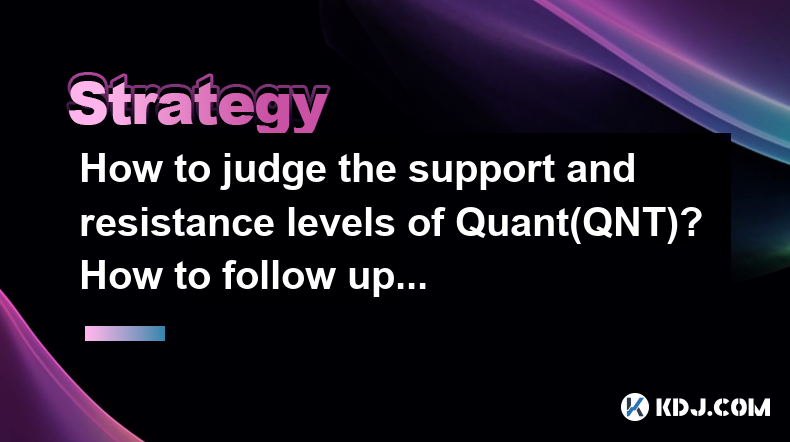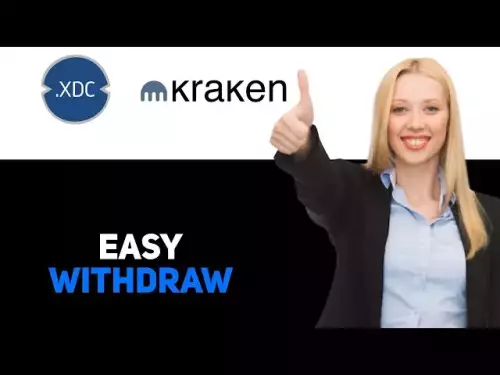-
 bitcoin
bitcoin $114684.631706 USD
-0.87% -
 ethereum
ethereum $4228.677447 USD
1.58% -
 bnb
bnb $1294.880693 USD
-1.16% -
 tether
tether $1.000819 USD
-0.02% -
 xrp
xrp $2.605138 USD
2.79% -
 solana
solana $209.908690 USD
5.89% -
 usd-coin
usd-coin $0.999903 USD
-0.03% -
 dogecoin
dogecoin $0.213423 USD
2.93% -
 tron
tron $0.322721 USD
-0.10% -
 cardano
cardano $0.727247 USD
3.66% -
 hyperliquid
hyperliquid $42.339456 USD
6.05% -
 chainlink
chainlink $19.910811 USD
5.16% -
 ethena-usde
ethena-usde $1.000557 USD
0.00% -
 stellar
stellar $0.349734 USD
2.69% -
 bitcoin-cash
bitcoin-cash $543.848687 USD
-0.21%
How to judge the support and resistance levels of Quant(QNT)? How to follow up after the breakthrough?
Support and resistance levels for Quant (QNT) help traders identify potential price floors and ceilings, aiding in informed trading decisions based on historical data and technical indicators.
May 01, 2025 at 02:49 pm

Understanding Support and Resistance Levels for Quant (QNT)
Support and resistance levels are fundamental concepts in technical analysis that help traders and investors understand potential price movements in the cryptocurrency market, including Quant (QNT). These levels indicate where the price of QNT might find a floor (support) or a ceiling (resistance) due to a concentration of buying or selling interest. Understanding these levels can help in making informed trading decisions.
Identifying Support Levels for Quant (QNT)
Support levels are price points where the demand for QNT is strong enough to prevent the price from declining further. To identify these levels, you can follow these steps:
- Analyze Historical Price Data: Look at the historical price charts of QNT to identify where the price has bounced back from in the past. These points are potential support levels.
- Use Technical Indicators: Tools like moving averages, trend lines, and Fibonacci retracement levels can help pinpoint where support might occur. For instance, if the 50-day moving average has historically acted as a support for QNT, it could continue to do so.
- Volume Analysis: High trading volumes at certain price levels can indicate strong support. If QNT's price drops to a level where there was previously high buying volume, it might act as a support level again.
Identifying Resistance Levels for Quant (QNT)
Resistance levels are price points where the supply of QNT is strong enough to prevent the price from rising further. To identify these levels, consider the following:
- Historical Price Data: Similar to support, look at past price charts to see where QNT's price has struggled to break through. These points are potential resistance levels.
- Technical Indicators: Use tools like trend lines, moving averages, and Bollinger Bands to identify where resistance might occur. For example, if the 200-day moving average has historically acted as a resistance for QNT, it could continue to do so.
- Volume Analysis: High trading volumes at certain price levels can indicate strong resistance. If QNT's price rises to a level where there was previously high selling volume, it might act as a resistance level again.
Following Up After a Breakthrough in Quant (QNT)
When QNT breaks through a support or resistance level, it can signal a significant shift in market sentiment. Here's how to follow up after such a breakthrough:
- Confirm the Breakthrough: Ensure that the breakthrough is genuine by waiting for the price to close above the resistance or below the support level. A false breakout can occur if the price quickly reverses.
- Assess Volume: A breakthrough accompanied by high trading volume is more likely to be sustainable. Low volume breakouts might be less reliable.
- Set New Support and Resistance Levels: After a breakthrough, the old resistance level can become a new support level, and vice versa. Monitor these new levels to understand the next potential price movements.
- Adjust Trading Strategy: Depending on whether the breakthrough is bullish or bearish, adjust your trading strategy accordingly. For a bullish breakthrough, consider buying or holding; for a bearish breakthrough, consider selling or shorting.
Using Technical Analysis Tools for Quant (QNT)
To effectively judge support and resistance levels for QNT, you can use various technical analysis tools. Here's how to use some of these tools:
- Moving Averages: Plot moving averages on your QNT price chart. The 50-day and 200-day moving averages are commonly used. If the price of QNT stays above these averages, they can act as support levels; if it stays below, they can act as resistance levels.
- Trend Lines: Draw trend lines connecting the highs and lows of QNT's price movements. These lines can help identify potential support and resistance levels.
- Fibonacci Retracement: Apply Fibonacci retracement levels to QNT's price chart to identify potential support and resistance levels based on the golden ratio. Common levels to watch are 38.2%, 50%, and 61.8%.
Practical Example of Identifying Support and Resistance for Quant (QNT)
Let's walk through a practical example of identifying support and resistance levels for QNT:
- Step 1: Open a price chart for QNT on a reliable cryptocurrency trading platform or charting tool.
- Step 2: Look at the past six months of price data to identify where QNT's price has bounced back from (potential support) and where it has struggled to break through (potential resistance).
- Step 3: Plot the 50-day and 200-day moving averages on the chart. Note where these averages have historically acted as support or resistance.
- Step 4: Draw trend lines connecting the highs and lows of QNT's price movements. These lines can help confirm the identified support and resistance levels.
- Step 5: Apply Fibonacci retracement levels to the most recent significant price movement of QNT. Note the levels where the price might find support or resistance.
Following Up After a Breakthrough: A Detailed Approach
After identifying and confirming a breakthrough in QNT's price, follow these detailed steps:
- Confirm the Breakthrough: Wait for the price to close above the resistance or below the support level for at least one candlestick period. This helps ensure the breakthrough is not a false breakout.
- Check Volume: Look at the trading volume during the breakthrough. If the volume is significantly higher than average, it supports the validity of the breakthrough.
- Identify New Levels: After a bullish breakthrough, the old resistance level can now act as a new support level. Conversely, after a bearish breakthrough, the old support level can now act as a new resistance level. Mark these new levels on your chart.
- Adjust Your Strategy: If the breakthrough is bullish, consider buying QNT or holding your current position. If it's bearish, consider selling or shorting QNT. Set stop-loss orders to manage risk.
- Monitor Price Action: Keep an eye on how QNT's price behaves around the new support and resistance levels. If the price respects these new levels, it can confirm the validity of the breakthrough.
Frequently Asked Questions
Q1: How often should I update my support and resistance levels for QNT?You should update your support and resistance levels for QNT regularly, ideally on a daily or weekly basis, depending on your trading timeframe. Market conditions can change, and new levels may emerge as the price of QNT evolves.
Q2: Can support and resistance levels for QNT change over time?Yes, support and resistance levels for QNT can change over time. As the price of QNT moves, new levels can form, and old levels may no longer be relevant. It's important to continuously monitor and adjust your analysis.
Q3: What other factors should I consider when analyzing support and resistance levels for QNT?In addition to technical analysis, consider market sentiment, news events, and overall market trends when analyzing support and resistance levels for QNT. These factors can influence the price and the effectiveness of the identified levels.
Q4: How can I use support and resistance levels to set stop-loss orders for QNT?You can use support and resistance levels to set stop-loss orders by placing them just below a support level if you're long on QNT, or just above a resistance level if you're short. This helps manage risk by limiting potential losses if the price moves against your position.
Disclaimer:info@kdj.com
The information provided is not trading advice. kdj.com does not assume any responsibility for any investments made based on the information provided in this article. Cryptocurrencies are highly volatile and it is highly recommended that you invest with caution after thorough research!
If you believe that the content used on this website infringes your copyright, please contact us immediately (info@kdj.com) and we will delete it promptly.
- XRP Price Prediction: Weekend Rollercoaster or Rally?
- 2025-10-12 08:45:16
- Bittensor (TAO): Super Bullish Signals Point to Potential 2x Rally
- 2025-10-11 10:25:12
- Silver Price Correction: Navigating the Dip & Identifying Key SEO Keywords
- 2025-10-11 10:25:12
- Decoding Crypto Trends: Bittensor's Bull Run, Cardano's Dip, and LivLive's Presale Buzz in 'Uptober 2025'
- 2025-10-12 08:45:16
- MoonBull: The Crypto Meme Coin Promising 1000x Gains?
- 2025-10-11 10:30:01
- Crypto Payroll Revolution: Stablecoins, Altcoins, and the Future of Salary Payments
- 2025-10-11 10:30:01
Related knowledge

Practical parameter settings for a Bitcoin multi-timeframe moving average system
Sep 18,2025 at 10:54pm
Optimizing Timeframe Combinations for Bitcoin Trading1. Selecting appropriate timeframes is crucial when building a multi-timeframe moving average sys...

How can I filter out false breakouts in Dogecoin high-frequency trading?
Sep 22,2025 at 01:00am
Understanding False Breakouts in Dogecoin Trading1. A false breakout occurs when Dogecoin's price appears to move beyond a defined support or resistan...

Techniques for identifying tops and bottoms in the Bitcoin on-chain NVT model
Sep 20,2025 at 07:54pm
Understanding the NVT Model in Bitcoin Analysis1. The Network Value to Transactions (NVT) ratio is often described as the 'P/E ratio' of the cryptocur...

What does the surge in open interest in Bitcoincoin futures mean?
Sep 20,2025 at 11:18pm
Understanding the Surge in Dogecoin Futures Open Interest1. A surge in open interest within Dogecoin futures indicates a growing number of active cont...

How can I use the Ethereum USDT premium to gauge market sentiment?
Sep 18,2025 at 11:55pm
Understanding the Ethereum USDT Premium1. The Ethereum USDT premium refers to the price difference between USDT (Tether) traded on Ethereum-based plat...

What should I do if Ethereum staking yields decline?
Sep 20,2025 at 06:18am
Understanding the Causes Behind Declining Ethereum Staking Yields1. The Ethereum network transitioned to a proof-of-stake consensus mechanism with the...

Practical parameter settings for a Bitcoin multi-timeframe moving average system
Sep 18,2025 at 10:54pm
Optimizing Timeframe Combinations for Bitcoin Trading1. Selecting appropriate timeframes is crucial when building a multi-timeframe moving average sys...

How can I filter out false breakouts in Dogecoin high-frequency trading?
Sep 22,2025 at 01:00am
Understanding False Breakouts in Dogecoin Trading1. A false breakout occurs when Dogecoin's price appears to move beyond a defined support or resistan...

Techniques for identifying tops and bottoms in the Bitcoin on-chain NVT model
Sep 20,2025 at 07:54pm
Understanding the NVT Model in Bitcoin Analysis1. The Network Value to Transactions (NVT) ratio is often described as the 'P/E ratio' of the cryptocur...

What does the surge in open interest in Bitcoincoin futures mean?
Sep 20,2025 at 11:18pm
Understanding the Surge in Dogecoin Futures Open Interest1. A surge in open interest within Dogecoin futures indicates a growing number of active cont...

How can I use the Ethereum USDT premium to gauge market sentiment?
Sep 18,2025 at 11:55pm
Understanding the Ethereum USDT Premium1. The Ethereum USDT premium refers to the price difference between USDT (Tether) traded on Ethereum-based plat...

What should I do if Ethereum staking yields decline?
Sep 20,2025 at 06:18am
Understanding the Causes Behind Declining Ethereum Staking Yields1. The Ethereum network transitioned to a proof-of-stake consensus mechanism with the...
See all articles

























![[4K 60fps] Prisma by novichokk (1 Coin) [4K 60fps] Prisma by novichokk (1 Coin)](/uploads/2025/10/14/cryptocurrencies-news/videos/k-fps-prisma-novichokk-coin/68ee49804ba00_image_500_375.webp)
















































